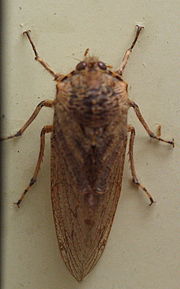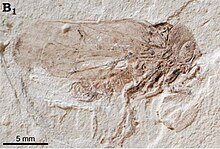Tettigarctidae
| Tettigarctidae Temporal range:
| |
|---|---|

| |
| specimen in the Australian Museum | |
| Scientific classification | |
| Kingdom: | Animalia |
| Phylum: | Arthropoda |
| Class: | Insecta |
| Order: | Hemiptera |
| Superfamily: | Cicadoidea |
| Family: | Tettigarctidae Distant, 1905 |


The Tettigarctidae, known as the hairy cicadas, are a small relict (mostly extinct) family of primitive cicadas. Along with more than 20 extinct genera, Tettigarctidae contains a single extant genus, Tettigarcta, with two extant species, one from southern Australia () and one from the island of Tasmania (). Fossil taxa include from the Miocene of New Zealand,[1] from the Paleocene of France,[2] and Sanmai from the Late Jurassic of China,[3] and Maculaferrum of early Late Cretaceous Canada.[4]Tettigarcta are the closest living relatives of the true cicadas.[5][6]
Genera[]
Only one genus in the family Tettigarctidae is not extinct, Tettigarcta.[7][8]
Dates given in million years ago (Ma).
Family Tettigarctidae
- † Jiang et al. 2019 - Burmese amber, Myanmar, 99 Ma
- † Tillyard, 1919 Blackstone Formation Australia, 227–208.5 Ma
- † Lambkin, 2019 Blackstone Formation Australia, 227–208.5 Ma
- † Qiao et al, 2021 Burmese amber, Myanmar, 99 Ma
Subfamily Cicadoprosbolinae Evans, 1956
- † Zheng et al. 2016 - Daohugou Beds, China, 164.7 to 155.7 Ma
- Tribe Turutanoviini Scherbakov, 2008
- † Liu et al. 2016 - Daohugou Beds, China, 164.7 to 155.7 Ma
- † Sanmai Chen, Zhang & Wang B 2016 - Daohugou Beds, China, 164.7 to 155.7 Ma
- † Becker-Migdisova 1949 (syn- Whalley 1985 according to Chen et al 2016) Daohugou Beds. China, Kyrgyzstan, Charmouth Mudstone Formation, United Kingdom, 189.6 to 155.7 Ma
- † Chen, Wang, Zhang & Wang, 2014 - Daohugou Beds, China, 164.7 to 155.7 Ma
- † Becker-Migdisova 1949 - Karabastau Formation, Kazakhstan, Mongolia, 164.7 to 112.6 Ma
- Tribe Cicadoprosbolini Evans, 1956
- † Martynov 1937 - , Kyrgyzstan, Tajikistan, 189.6 to 183.0 Ma
- † Becker-Migdisova 1947 - , Kyrgyzstan, 201.6 to 189.6 Ma
- † Chen and Wang 2016 - Daohugou Beds, China, 164.7 to 155.7 Ma
- † Shcherbakov 1988 - , Russia, 125.45 to 122.46 Ma
- † Shcherbakov 2008 - , China, 136.4 to 125.45 Ma
- † Lameere and Severin 1897 - Sainte-Barbe Clays Formation, Belgium, 130.0 to 122.46 Ma
- † Fu, Cai and Huang, 2019 Burmese amber, Myanmar, 99 Ma
- †"Liassocicada" ignota Brodie 1845, Lilstock Formation, United Kingdom 205.6 - 201.6 Ma
- Tribe Architettigini Scherbakov, 2008
- † Hamilton 1990 - Crato Formation, Brazil, 122.46 to 112.6 Ma (million years ago)
Subfamily Tettigarctinae Distant, 1905
- † Fu, Cai and Huang, 2019 Burmese amber, Myanmar, 99 Ma
- Tribe Protabanini Hong, 1982
- † Zeuner 1944 - Ardtun Head, Isle of Mull, United Kingdom, 58.7 to 55.8 Ma
- † Bode 1953 - Posidonia Shale Germany 183.0 - 182.0 Ma
- † Shcherbakov 2008 - Douiret Formation, Tunisia, 125.45 to 112.6 Ma
- † Hong 1982 - Jiulongshan Formation, China, 164.7 to 155.7 Ma
- † Hong 1983 - Daohugou Beds, Jiulongshan Formation, China, Karabastau Formation Kazakhstan, 164.7 to 155.7 Ma
- † Menon 2005 - Crato Formation, Brazil, 122.46 to 112.6 Ma
- † Demers-Potvin et al 2020 - Redmond Formation, Canada, 99.7 to 94.3 Ma
- Tribe Meunierini Boulard et Nel, 1990
- † Martynov 1937 - Kyzyl-Kiya, Kyrgyzstan, 189.6 to 183.0 Ma
- † Piton 1936 - Menat Formation, France, 58.7 to 55.8 Ma
- Tribe Tettigarctini Distant, 1905
- † Kaulfuss & Moulds 2015 - Hindon Maar, New Zealand, 23.03 to 15.97 Ma
- Tettigarcta White, 1845 - Australia, extant
See also[]
References[]
- ^ Kaulfuss, Uwe; Moulds, Max (2015). "A new genus and species of tettigarctid cicada from the early Miocene of New Zealand: Paratettigarcta zealandica (Hemiptera, Auchenorrhyncha, Tettigarctidae)". ZooKeys (484): 83–94. doi:10.3897/zookeys.484.8883. PMC 4361785. PMID 25829843.
- ^ Piton, L., 1936a. Les Hémiptères-Homoptères de l'Écène de Menat. (P.-de-D.). Miscellaneous Entomologica. Revue entomologique internationale. Narbonne. 37: 93-94.
- ^ Chen, Jun; Zhang, Haichun; Wang, Bo; Zheng, Yan; Wang, Xiaoli; Zheng, Xiaoting (2016). "New Jurassic tettigarctid cicadas from China with a novel example of disruptive coloration". Acta Palaeontologica Polonica. 61 (4): 853–862. doi:10.4202/app.00238.2015.
- ^ Demers-Potvin, Alexandre & Szwedo, Jacek & Paragnani, Cassia & Larsson, Hans. (2020). First North American occurrence of hairy cicadas discovered in a Late Cretaceous (Cenomanian) exposure from Labrador, Canada. Acta Palaeontologica Polonica. 65. 85-98. 10.4202/app.00669.2019.
- ^ Marshall, David C.; Moulds, Max; Hill, Kathy B. R.; Price, Benjamin W.; et al. (2018). "A molecular phylogeny of the cicadas (Hemiptera: Cicadidae) with a review of tribe and subfamily classification". Zootaxa. 4424 (1): 1–64. doi:10.11646/zootaxa.4424.1.1. PMID 30313477.
- ^ Cryan, JR; Urban, JM (2011). "Higher-level phylogeny of the insect order Hemiptera: is Auchenorrhyncha really paraphyletic?". Systematic Entomology. 37 (1): 7–21. doi:10.1111/j.1365-3113.2011.00611.x.
- ^ Moulds, M.S. (2018). "Cicada fossils (Cicadoidea: Tettigarctidae and Cicadidae) with a review of the named fossilised Cicadidae". Zootaxa. 4438 (3): 443–470. doi:10.11646/zootaxa.4438.3.2. PMID 30313130.
- ^ Behrensmeyer; Turner, A. "Family Tettigarctidae Distant 1905 (hairy cicada)". Fossilworks, Taxonomic occurrences of Suidae recorded in the Paleobiology Database.
External links[]
- CSIRO Tettigarctid page
- A photo of a Tettigarcta tomentosa
 Media related to Tettigarctidae at Wikimedia Commons
Media related to Tettigarctidae at Wikimedia Commons Data related to Tettigarctidae at Wikispecies
Data related to Tettigarctidae at Wikispecies
- Tettigarctidae
- Auchenorrhyncha families
- Cicadas
- Auchenorrhyncha stubs